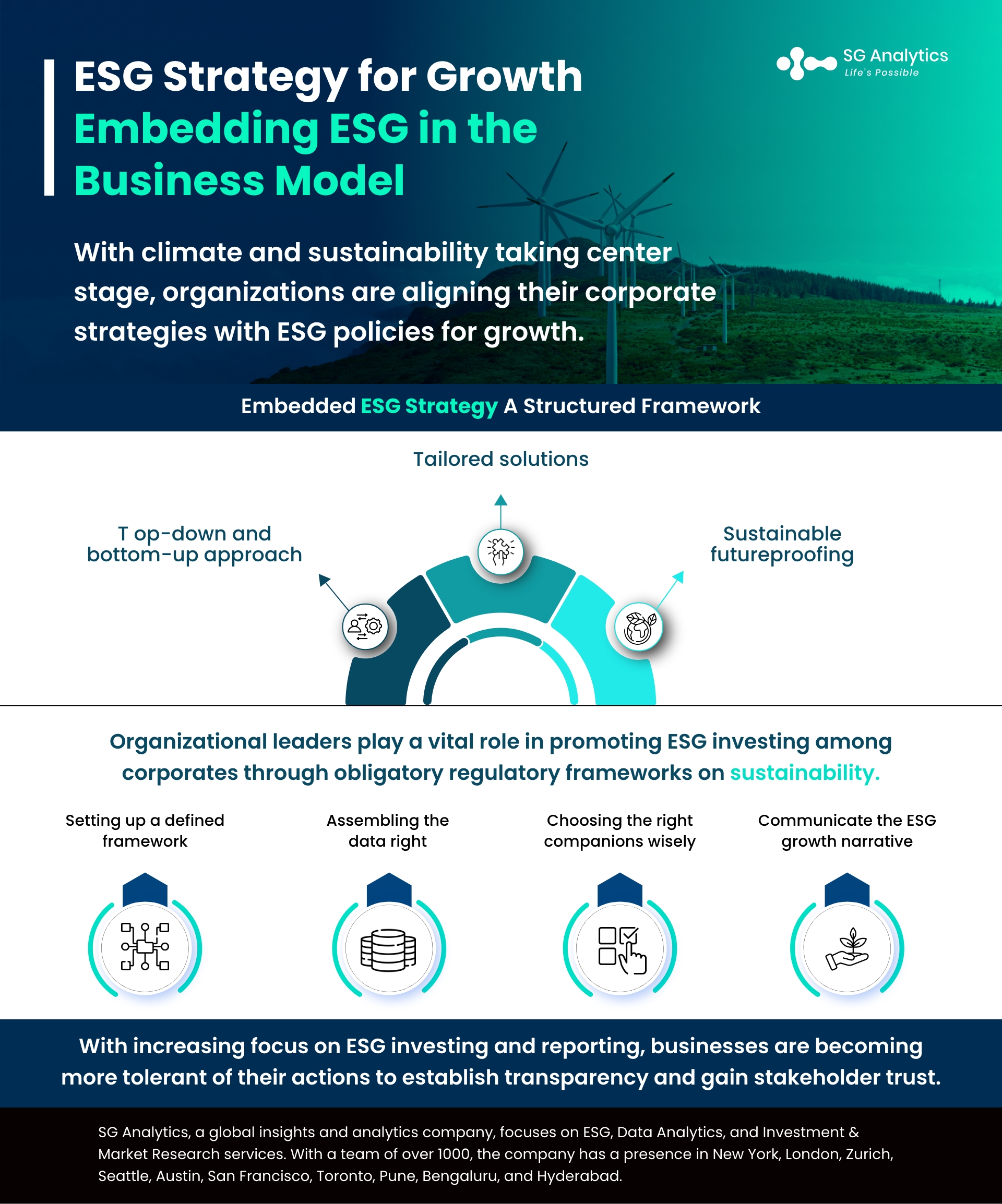With climate and sustainability taking center stage in every operational framework, organizations are paying more attention to environmental, social, and governance (ESG). However, only a few organizations have been able to align their strategies with it.
Today organizations need to plug a comprehensive ESG vision into their corporate strategy in order to deliver immense financial and non-financial value. The financial value can be in the form of increased productivity, cost reduction, fostering the usage of sustainable products & solutions, and better access to finance. Further, ESG-focused companies need to establish better operational efficiency to lower employee turnover rates and support innovation with strong governance and better risk management.
Organizations focusing on ESG initiatives tend to attract more investments as the demand for sustainable investing is advancing rapidly. ESG investing is picking up a steady pace and emerging as a mandatory factory for companies looking to make sustainability and ESG an integral component of their business model.
Stakeholders - investors, policymakers, regulators, and customers - today expect organizations to disclose their sustainability plans and how the set business model will be compatible with driving a net-zero economy. However, this presents a challenge for them as it may require decades of effort to explore as well as implement opportunities within the existing operational framework.
Read more: The Role of Artificial Intelligence in Achieving Sustainability and Profitability

Embedded ESG Strategy: A Structured Framework
Many organizations are embedding ESG principles into their core corporate strategy to establish a more resilient and sustainable business model as the focus on the ESG framework continues to sharpen.
Tailored Solutions: The embedded ESG framework mandates a tailored strategic solution. The strategy requires structured frameworks for a business that meets its specific needs and goals. The solutions can vary based on the type of business, sector, investor base, supply chains, and workforce.
A critical starting point for a corporate ESG strategy is to determine the top opportunities as well as the risks. This is important in the early stages of designing a strategy that assists in addressing that every ESG issue requires the same level of attention. Engagement within the organization, along with key stakeholders, further helps in determining the top opportunities for growth. A tailored ESG strategy will lead to influential interactions with employees, partners, and other stakeholders, thereby improving the organization's ESG performance.
Sustainable Futureproofing: Embedded ESG strategies help businesses in designing a sustainable future-proofing plan for the long term. Different businesses have different areas that are the most important to them. With climate risk dominating the ESG dialogue across sectors, workplace issues related to conservation, diversity, equity, and inclusion, along with employee well-being, are becoming more prominent.

Businesses are now taking further steps to future-proof their ESG issue across supply chains and other domains. Companies are making ESG policies a priority when selecting their associates. There has been a shift to adopt more resilient and sustainable.
Top-down and bottom-up approach: Embedded ESG strategy mandates both top-down as well as bottom-up approaches. With the development of the ESG platform, priorities and communications are emerging from the top and integrating throughout the organizational operations. Through a defined ESG lens, organizations are applying decision-making frameworks that help establish meaningful engagement with employees, partners, and other stakeholders. Businesses are adopting a holistic approach to embed ESG into their mission, vision, and values, thereby making it part of their culture.
Read more: The Future of Corporate Sustainability: 2023 Predictions
The Underlying Concerns and Solutions
Organizations often fail to recognize ESG plans as they do not get prioritized. This has led to undefined goals, along with unclear ownership and a lack of a defined approach to achieve the set vision.
Setting up a defined framework: By defining the organizational ESG priorities and associated objectives, organizations can work towards achieving the time-bound targets and drive key performance indicators for performance. Many organizations often make sense of the leveraged ESG data to drive business objectives. And if the data is siloed across extended business relationships and service providers, it becomes difficult to gain a unified view of the initiatives. To overcome this, organizations are now embedding their ESG priorities within the corporate framework to stay on track.

Assembling the data right: Gathering the right insights for ESG strategies can assist businesses to sail smoothly on this journey. Many organizations are deriving more value by collaborating with diverse business ecosystems to simplify their data collection and reporting. Consumer-facing organizations are also enhancing the maturity of their sustainability programs to strategize their ESG policies and have a tangible impact.
Choosing the right companions wisely: Staying ESG-focused needs to be one of the driving factors when selecting third parties. Organizations can easily monitor and evaluate the new as well as existing third-party relationships and their impacts on ESG priorities. With consumers demanding more transparency on ESG matters, organizations have to disclose their environmental footprint as well as display their ethical and responsible sourcing to demonstrate their responsibilities to their people and community.
Read more: Sustainability in Tech: 3 Ways for Companies to Become More Sustainable
Communicate the ESG growth narrative: By telling the ESG vision clearly, businesses can win consumer support. However, they need to develop a method to monitor their organizational ESG matters and align them with a standard reporting framework to follow on the sustainability journey. Organizations are now aiming to reach net zero by the year 2050 to avoid the most catastrophic impacts of climate change. They should also strengthen their operations to lower carbon emissions and adopt new sustainable practices to move toward the goal.
Today consumers are searching for truly environmentally responsible organizations. Organizations are therefore making fundamental changes to their DNA - corporate strategy - and aligning it with principles to facilitate improvements to environmental, social, and governance (ESG).

Bringing Corporate ESG into the Mainstream
There has been a shift in management thinking with regard to incorporating the benefits of ESG to gain ground. There are several ways corporates are integrating ESG into their decision-making strategies to lead sustainable development:
-
Clear accountability and oversight across the Board level are enabling organizations to achieve Board-level ESG committees or individual positions like Chief Sustainability Officer (CSO) are being formulated to foster sustainable decisions further. At the management level, senior executives are taking responsibility to ensure that future investments are ESG-centric. They are cultivating a sustainability culture that is embedded at the bottom of the organizational pyramid.
-
Organizations are setting ambitious ESG targets for their business and preparing implementation roadmaps to achieve the defined goals. While conducting the analysis, an organization needs to consider the inward impact as well as the outward impact of their decisions on the environment and society. This further helps in making operations resilient to ESG-related risks.
Read more: Sustainability Outlook: Top Emerging Trends in 2023 and Beyond
-
A critical component for any business, the supply chain issue, is equally significant. Organizations are imposing measures to identify the emission hot spots and address the underlying risks from a climate risk perspective. Businesses are taking stewardship responsibilities by instilling eco-design principles that consider product sustainability.

-
The journey toward sustainability also includes multiple stakeholders within the organization. It is, therefore, important for organizations to upskill their employees with ESG skills and enable them to appreciate their role by contributing towards the sustainability journey.
While adopting ESG is an active challenge, organizational leaders are playing a vital role in promoting ESG investing among corporates through obligatory regulatory frameworks on sustainability. With increasing focus on ESG investing and reporting, businesses are becoming more tolerant of their actions to establish transparency and gain stakeholder trust.
With a presence in New York, San Francisco, Austin, Seattle, Toronto, London, Zurich, Pune, Bengaluru, and Hyderabad, SG Analytics, a pioneer in Research and Analytics, offers tailor-made services to enterprises worldwide.
A leader in ESG Services, SG Analytics offers bespoke sustainability consulting services and research support for informed decision-making. Contact us today if you are in search of an efficient ESG (Environmental, Social, and Governance) integration and management solution provider to boost your sustainable performance.









